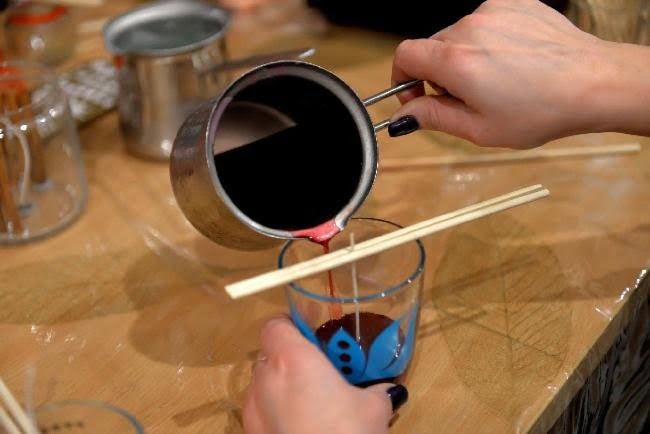If you are wondering what ordinary household items you can use as a candle wick, then read our comprehensive guide on using these simple materials to make your DIY candles at home.
A candle wick is a braided cotton strand used to hold the flame of a candle burning. The candle wick acts by conveying the gas to the flame by capillary movement. When the liquid fuel, typically molten candle wax, comes into contact with the flame, it vaporizes and burns. Diameter, fire resistance, and flexibility are all important characteristics of the wick.
Wicks are often braided flat, so that when they burn, they twist back to the flame, making them self-igniting. Because of the success of these wicks, the remaining wick was removed with special blades without trying to ignite the flame. Greater wick diameters result in a larger flame, a larger layer of molten wax, and a faster burning candle.
The wick is attached to a piece of metal in tea-lights to prevent it from rising to the surface of the molten wax and burning until the wax starts to burn. Candles are made to float in water, not only for wick connection but also for a lock on the bottom of the candle to keep the wick from collecting water and igniting the flame.
The wick on some birthday candles is just a piece of plastic. This reduces the candle’s ability to ignite for an extended period. Wicks may be made of materials other than rope or thread, such as wood, but this is uncommon. Tampon cotton may be used as a wick for oil lamps in a survival condition in the wilderness.
What Can I Use as a Candle Wick
A cotton string is all that you’ll need to make your candle wicks. You may make your candle wicks with salt or oil, but cotton string still works well enough as a candlewick. Cotton string candle wicks burn for a long time with a smooth, smoke-free flame. Moreover, you can use DIY candle wicks to make your candles and oil lamps.
Use string or thread that is entirely made of cotton. Use raw string, meaning unbleached and undyed string. Certain natural fabrics, such as linen, jute, or hemp, may be used instead of cotton. As compared to cotton, wool is usually fireproof and should not be used. And cotton wicks are perhaps the most popular wicks for candling.
Plain Cotton String Candle Wicks:
The first suggestion for you is the plain cotton string candle wicks that need only a plain cotton string for ignition.
Oil-Soaked Candle Wicks:
Cotton wicks may be soaked in vegetable oil or even expired cooking grease instead of using plain cotton string. It just takes a few minutes for the wick to be fully soaked in oil. Moreover, the oil does not need to be heated.
Salt-Treated Candle Wicks:
Place the cotton wicks in a tub of water with one tablespoon of salt in water. Wait for the water to get boiled. Then remove the candle wicks that have been treated with salt. Now dry the handmade candle wicks overnight. Candle wicks get harder when treated with salt.
How to Make Candle Wicks Without Borax?
Candle wicks prepared with borax are very common, but you can also make candle wicks without borax, such as moveable wicks or wooden wicks, using a variety of basic materials.
How to Make Wooden Candle Wicks:
Step 1:
Trim down balsa wood sticks: Trim the thickness of the balsa wood with scissors such that it is at least one inch (2.5 cm) taller than the container that you want to use for the candle.
Step 2:
Soak the balsa wood in olive oil: In a small bowl, place the cropped balsa wood. Fill the dish with enough room temperature olive oil to completely cover the wood. Though wood is flammable on its own, coating it with oil can help the fire catch and burn more efficiently. Olive oil burns clearly, making it an excellent option for candle-making.
Step 3:
Wipe away the extra oil: Separate the wooden sticks from the oil and brush away the excess oil with clean paper towels. Instead of rubbing the stick to dry, place it on a plate that is filled with paper towels and set it aside to air dry for a few minutes.
Step 4:
Attach a wick tab to the base of the stick: Pull the wick as far as possible into the tab. During the candle-making process, the wick tabs will keep the wood firmly in place while it stands in the molten wax.
Step 5:
Make use of the wick as needed: The wooden wick will now be prepared for use in the creation of your candle. Treated balsa wood is easy to burn efficiently. Using wooden wicks instead of cotton ones will give the candle a wooded smell when it burns.
How to Make Trendy Movable Candle Wicks:
Step 1:
Melt wax in a double boiler: In the top portion of a double boiler, break up 1/4 to 1/2 cup (60 to 125 ml) of paraffin or perhaps candle wax. Heat the wax until it is fully melted.
Step 2:
Twist the pipe cleaner end: Wrap the end of a pipe cleaner around the pencil or even the pen’s tip. Rotate the leftover pipe cleaner upwards until it quickly removes to the pencil’s edge or otherwise collides.
Step#3:
Trim the pipe cleaner: Trim the pipe cleaner’s long end with side cutter pliers. The completed wick can only be about 1/2 inch (1.25 cm) longer than the spherical base.
Step#4:
Dip the wick into the melted wax: Using long-handled tweezers gently lower the trimmed pipe cleaner wick into the molten wax. Allow the wick to soak in the wax for a few moments.
Step#5:
Dry the wick: Erase the wick from the wax and place it on an aluminum foil pan. Allow the wax to dry and gets harden for a few minutes. As the wick dries, place it on its circular foundation. When done, the wax on the wick should be cool and solid to the touch.
Step#6:
Repeat as desired: Repeat the drying and dipping process up to three times again, allowing the wax to harden between each layer.
Step#7:
Make use of the wick as needed: Once the wick has fully dried after the previous wax coating, it is finished and ready to step up on the top of a fantastic wickless candle. When you burn the wick, the flame should spread heat evenly across the wick through the candle under it.
How To Make A Popsicle Stick Candle Wick:
We’ve often thought that wooden wick candles were an expensive comfort that couldn’t be as good as they were advertised to be. Let’s take a review that how a popsicle can be used as a candlewick. For this, I wanted to make a candle out of all of the remaining wax from the candles I burn in my house, but I didn’t have any wick.
Then, opted for Popsicle sticks. It’s wick candles made of wood. Then, create a wick stand made up of two paper clips that are opposite to each other. One is clipped into the other and lies flat on the surface. The next one is currently on its side, keeping the Popsicle stick.
The next step is to melt the wax chips in a tin. Then dip the portion of the Popsicle stick that will be used as a wick in wax to make the wood melt more slowly and not burn out as easily. When pouring the wax and allowing it to cool, the paper clip helps in keeping the Popsicle stick in the middle and upright. If it falls over when cooling, it would be a failure.
Then stand the popsicle stick with the help of a cloth pin and burn out the extra-long stick. Now the candle is ready and is burning successfully. It looks like a tiny fireplace and smells wonderful.
Things You Should Consider While Using Candlewicks:
Candle wicks are normally the last option when it comes to candle making for some reason. If you want to avoid candlewick problems and create high-quality candles, choosing the right candle wicks is important. As you might be aware, the pans, wax type, and perfume you choose will be meaningless if you choose the wrong candle wicks.
Some factors should consider while using candle wicks:
The Diameter of the Candle:
Let’s start with the most important consideration when choosing candle wicks, the candle’s diameter. Fortunately, figuring out the first move is very straightforward.
Fragrance Load and Color:
The next phase is to think about how much style or scent you’re going to put into the candle. The stronger your wick should be the more scent you need.
Candle Wax Type:
The kind of candle wax you use will be the focus of the next phase. Each type of candle wax has a different melting point and density. These differences affect the candlewick style that can be used.
Candle Burn Time:
Last but not least, think of the wax’s burn rate. If you choose to flame the candle for shorter periods, such as one to 1.5 hours rather than the recommended four hours, a thicker wick is recommended to create a pool of melted wax.
I like making my own candles. It’s a hobby that’s both relaxing and budget friendly.
Final Words:
The wick is a very important component of your candle. You can think about something as a gas line. When the wick burns, it melts a portion of the wax and releasing a fragrant scent!
The majority of candle wicks will have a nice solid core that will allow them to stay upright in molten candle wax. A wick’s role is to bring fuel (wax) to the flame. Various wick sizes offer different amounts of fuel to get flamed.








